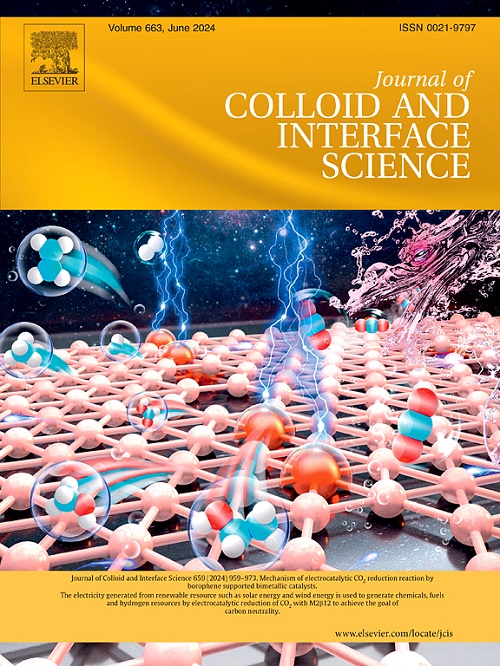先进钠离子电池阳极用双氧化还原位二茂铁基金属有机骨架
IF 9.7
1区 化学
Q1 CHEMISTRY, PHYSICAL
引用次数: 0
摘要
传统的钠离子电池(SIB)阳极在容量、反应动力学和循环稳定性方面仍然存在滞后,这促使高性能阳极的发展以推进电网规模的储能。在此,我们报道了一种具有双氧化还原位点的二茂铁基金属-有机框架(NF-MOF)阳极,通过简单的溶剂热法在碳布(CC)上合成。这种创新的设计产生了一种无粘结剂NF-MOF@CC阳极,将二茂铁(Fc/Fc+)的氧化还原活性与Ni0/Ni2+氧化还原偶对集成在一起。谨慎的设计确保了NF-MOF和CC之间的紧密界面接触,消除了粘合剂引起的阻力,并通过分层孔隙度容纳Na+引起的应变。结果,NF-MOF@CC表现出快速的电容主导Na+存储和高扩散系数,在0.1 ag−1时提供705 mAh g−1的高可逆容量,实现了比粉末高3.9倍的容量。非原位结构和模拟研究证实了可逆的Ni和Fe氧化还原反应具有最小的晶格畸变,而静电电位映射确定了最佳的Na+吸附位点。此外,与Na3V2(PO4)3或NaNiFeMn2O6阴极配对的全电池结构具有显著的可循环性,分别保持95.1%(第200次循环)和95.3%(第500次循环)的容量,同时具有高能量密度(3160 W kg - 1时310 Wh kg - 1)。这项工作开创了双氧化还原MOF设计策略,为坚固的高容量SIB阳极提供了通用平台。本文章由计算机程序翻译,如有差异,请以英文原文为准。

Ferrocene-based metal-organic frameworks with dual redox sites for advanced sodium-ion battery anodes
Conventional sodium-ion battery (SIB) anodes are still lagging in capacity, reaction kinetics, and cycling stability, which motivates the development of high-performance anodes for advancing grid-scale energy storage. Herein, we report a ferrocene-based metal-organic framework (NF-MOF) anode with dual redox sites, synthesized on carbon cloth (CC) via a facile solvothermal method. This innovative design yields a binder-free NF-MOF@CC anode that integrates the redox activity of ferrocene (Fc/Fc+) with the Ni0/Ni2+ redox couple. The prudent design ensures intimate interfacial contact between NF-MOF and CC, eliminating binder-induced resistance and accommodating Na+-induced strain through hierarchical porosity. As a result, NF-MOF@CC shows rapid capacitive-dominated Na+ storage and high diffusion coefficients, delivering a high reversible capacity of 705 mAh g−1 at 0.1 A g−1 and achieving a 3.9-time higher capacity than its powder counterpart. Ex situ structural and simulation studies confirm reversible Ni and Fe redox reactions with minimized lattice distortion, while electrostatic potential mapping identifies optimal Na+ adsorption sites. Moreover, full-cell configurations paired with Na3V2(PO4)3 or NaNiFeMn2O6 cathodes achieve remarkable cyclability, retaining 95.1 % (200th cycle) and 95.3 % (500th cycle) capacity, respectively, alongside high energy densities (310 Wh kg−1 at 3160 W kg−1). This work pioneers a dual-redox MOF design strategy, offering a universal platform for robust, high-capacity SIB anodes.
求助全文
通过发布文献求助,成功后即可免费获取论文全文。
去求助
来源期刊
CiteScore
16.10
自引率
7.10%
发文量
2568
审稿时长
2 months
期刊介绍:
The Journal of Colloid and Interface Science publishes original research findings on the fundamental principles of colloid and interface science, as well as innovative applications in various fields. The criteria for publication include impact, quality, novelty, and originality.
Emphasis:
The journal emphasizes fundamental scientific innovation within the following categories:
A.Colloidal Materials and Nanomaterials
B.Soft Colloidal and Self-Assembly Systems
C.Adsorption, Catalysis, and Electrochemistry
D.Interfacial Processes, Capillarity, and Wetting
E.Biomaterials and Nanomedicine
F.Energy Conversion and Storage, and Environmental Technologies

 求助内容:
求助内容: 应助结果提醒方式:
应助结果提醒方式:


